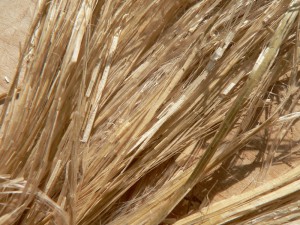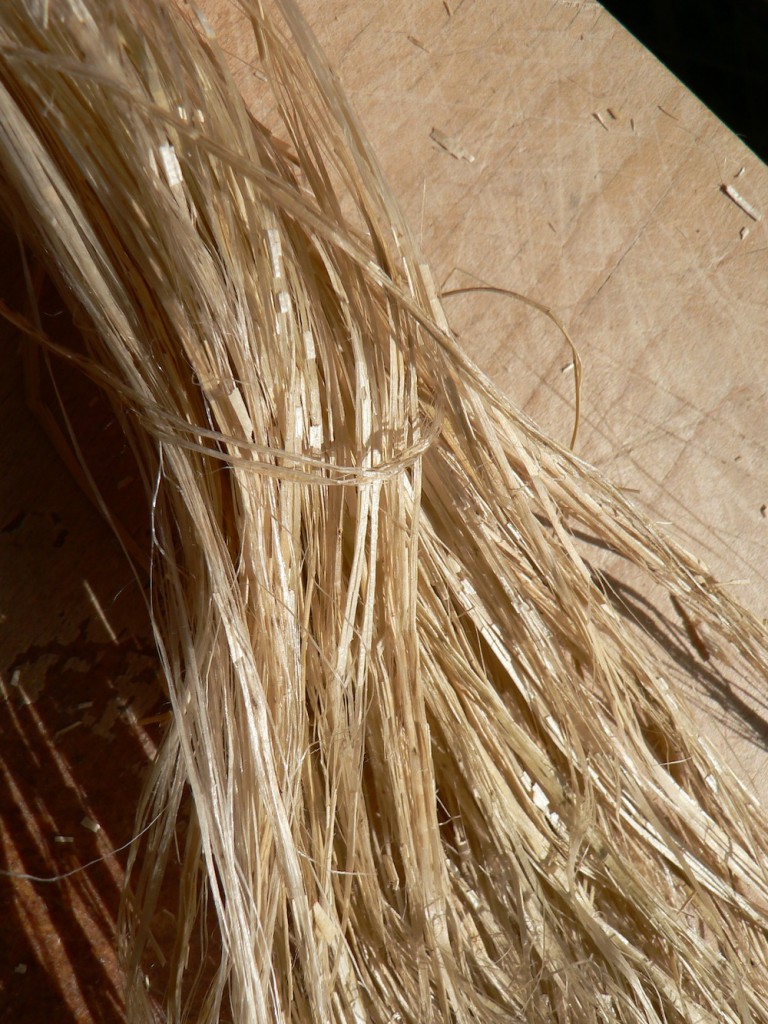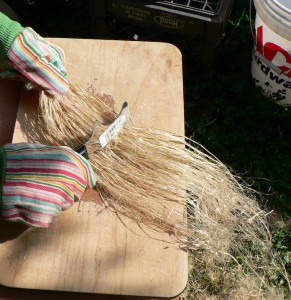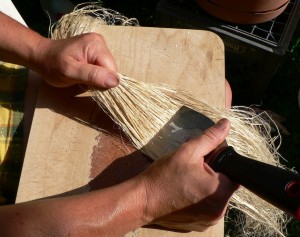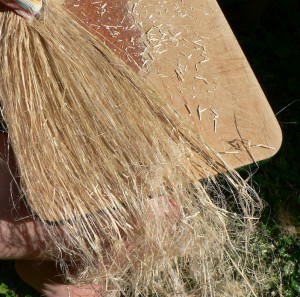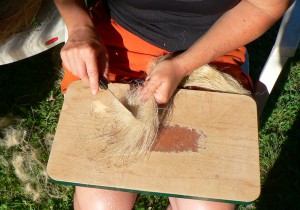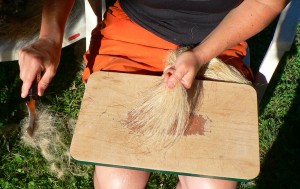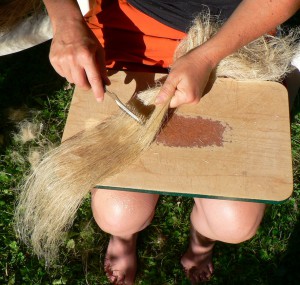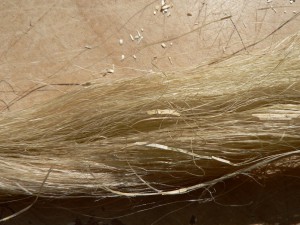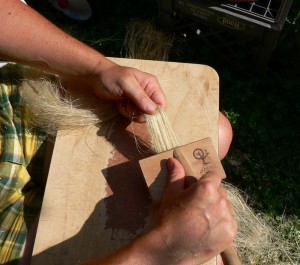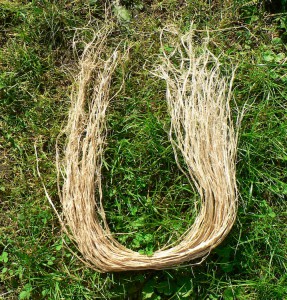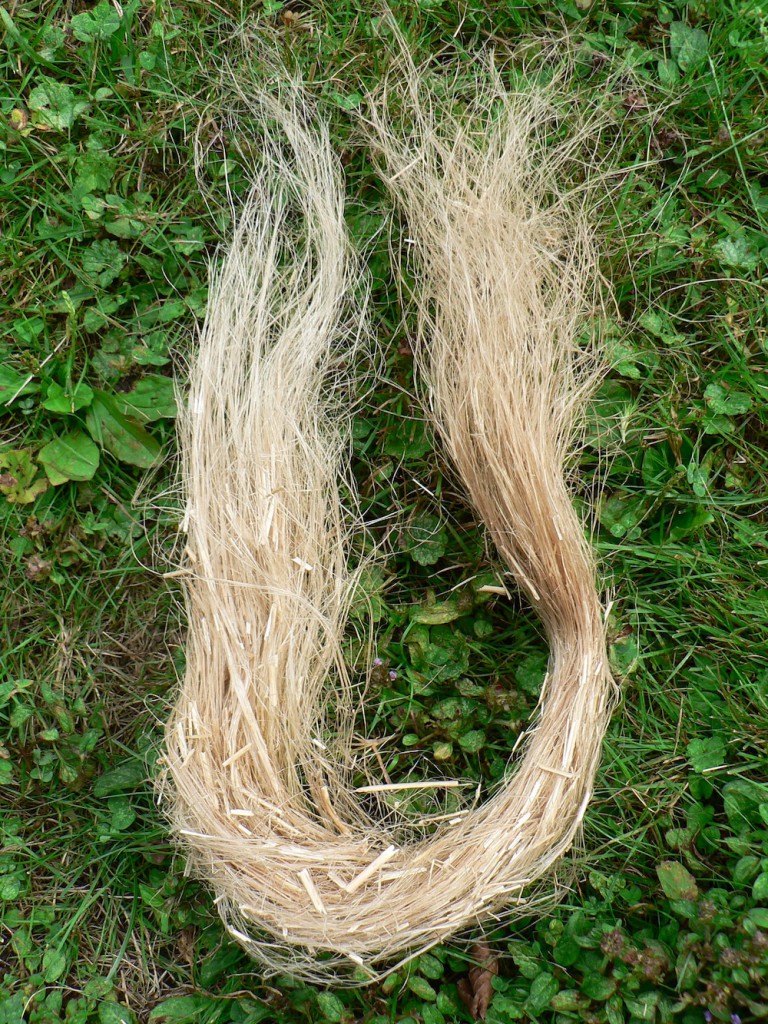After I wrote about our gloriously low-humidity weather, which provided the perfect climate for dressing flax, I realized I had not included any photos. Here are some illustrations of my modified “hardware store tools” technique, including a new innovation since last time I posted about using this method.
The hardware store tools that I use are a paintbrush cleaning tool, a 3-inch-wide joint compound knife, a wooden cutting board, and a flick carder designed for wool. And a dust mask. And gloves. The gloves are new, but my hands have been a lot more sensitive this summer.
I’ve been dressing largely under-retted flax which has already been broken with a flax brake. The bundles I made to dry and ret the flax are too large to handle all at once using this method, so I separate them into thirds or even fourths. The reason I think the flax is under-retted is that the cuticle, or skin, of the stalk is really hard to get off, and the fibers stick together in ribbons. The lighter colored, papery-looking pieces below are the cuticle.
Here’s another view of a bundle before I get to work.
Initially, my first step was to scrape a portion of a bundle of flax with the joint compound knife to break up the remaining woody material and scrape it off. However, after a few days of doing this (about 2 or 3 hours a day, in the afternoon when the humidity was lowest) my hands were killing me.
The innovation I stumbled across last week was to drag the paintbrush cleaning tool through the bundle first. It smashes up a lot of the woody pieces into much smaller pieces and pops them off. It requires much less pressure to do so at this stage than using the joint compound tool right away. As with traditional tools, I start at the end of the bundle, and move my way toward the center, then flip the bundle around and do the same on the other end. The center of the bundle is the hardest to clean.
A lot of big pieces of tow come off at this point.
Step two is to use the joint compound knife to scrape off more of the woody or straw-like bits. It works best to pull up on the flax slightly while I’m scraping.
The remaining shives (woody or straw-like bits) are small at this point.
Then I use the brush cleaning tool again like a coarse hetchel.
The tow that comes off at this point is shorter but much cleaner. You can see it dropping off the knife on the left above.
I start of the end of the bundle, and work toward the middle, then flip it over. In the photo below I have cleaned one end pretty nicely, but the end under my left wrist is still tangled and full of tow.
After all this, there is usually some cuticle still clinging on tightly. That’s the hardest part to remove. In the process of getting it off, I feel like I break up a lot of otherwise useful long fibers. Below you can see a mostly clean section with a few bits of cuticle still stuck on:
After this I use the flick carder as a “fine hetchel” and it scrapes off most of the remaining straw pieces, aligns, and smooths the long fibers.
After I clean up all the sections of a bundle, I tie them back together into their original configuration. It is pretty easy to tell the root end from the branch end because they are different colors.
Below you can see a bundle of flax before cleaning. The branch end on the left is darker and the root end on the right is lighter.
And below is a bundle after a little cleaning. The root end is on the left this time, and the branch end on the right. The color difference is still noticeable.
As much as possible, I have been trying to keep track of the flax I grew from different seed varieties, different years, and in different locations. In some years I’ve even managed to label the batches from different retting tanks. When I started working with flax lo these many years ago, I imagined that I might be able to strike upon the optimal conditions for creating long, fine flax. However, there are so many factors to consider that I’m not sure I will ever find the “best” combination of seed type, soil/location, length of ret, etc.. And even if I could, I’m not sure I could ever duplicate the best results. However, I am now several steps closer to spinning my flax, which is exciting!

